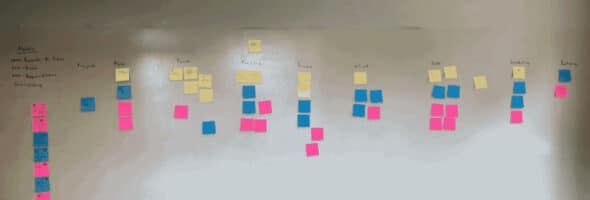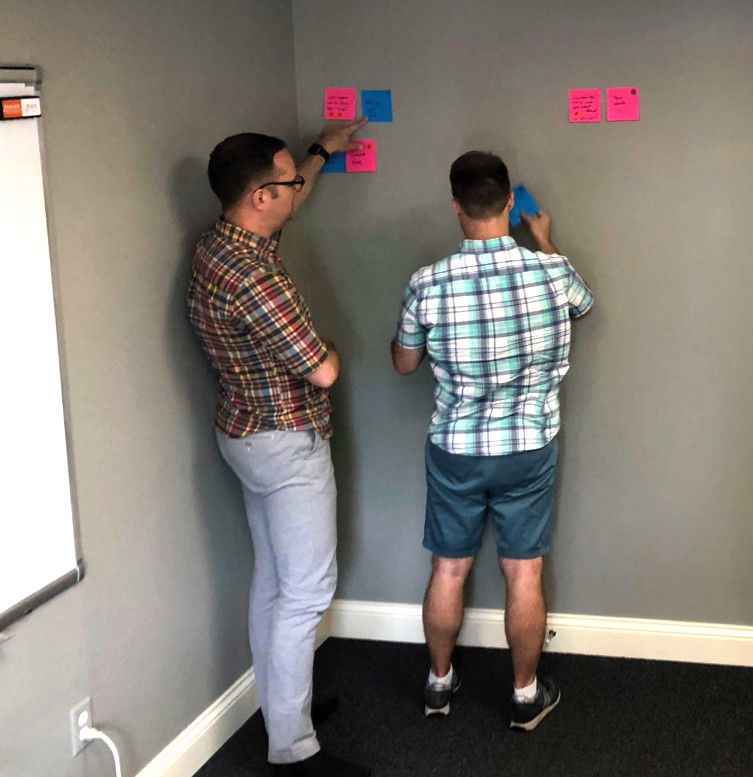Article summary
Design Thinking is a powerful method for solving tricky problems and gaining stakeholder consensus. Key performance indicators (KPIs) are valuable because they encourage the team to measure, reflect, and react to the things that matter.
When KPIs are done right, a team gains shared focus, and performance increases.
But, KPIs are not easy to get right. They commonly fail for a few key reasons.
- The team gets overwhelmed and fails to create them.
- The wrong KPIs are implemented, and the team focuses on the incorrect objectives.
- The team creates too many and never achieves focus.
Using Design Thinking to define KPIs is an ideal approach.
Below, I’ll outline a process and set of concrete actions for a Design Thinking KPI workshop. I’ll also include an approach for synthesis and a step-by-step plan for implementation.
Design Thinking KPI Workshop
Here’s the agenda of a workshop agenda I’ve facilitated with our team.
| Time required | 2 hours |
| Participants | Team members that’ll be responsible for owning the KPIs. This workshop works best for two to four team members. If your team is bigger, consider running multiple workshops. Then share the output with the other team members. |
| Materials needed | Yellow, orange, blue, and pink sticky notes, black sharpies for all team members, a bunch of small circle stickers, and a shared whiteboard |
Segue (3 mins)
Segues are simple transitions that help everyone leave behind the worries of the day and focus on being fully present in the meeting.
Action: Pre-determine an appropriate segue and use it to kick off the meeting.
Hopes (10 mins)
It’s common for the team to feel apprehension when discussing KPIs. That’s because KPIs frequently mean judgment in many organizations. In my opinion, that is a poisonous mindset. KPIs are simply indicators that help a team understand what part of the business requires attention. If done right, they’ll reduce team stress not increase it.
Because of this common misconception, I like to begin the workshop with a hopes and dreams exercise.
Actions:
- Ask the team to use their yellow sticky notes, and write down a few items they’re hoping to get out of the workshop.
- Have the team stick their answers to the shared whiteboard.
- Have the team take turns sharing their answers.
Agenda (2 mins)
Action: Write the remaining agenda on the whiteboard for the team to see.
Remember the Future (30 mins)
Remember the Future is a great activity to better understand the team’s definition for success. It can be invaluable for identifying larger themes of improvement.
I’ve found it valuable to ask a similar question in three different ways.
Actions:
- First, draw a timeline on the whiteboard. Start the timeline with today’s date. Add another point on the timeline that is one year in the future.
- Next, ask the team to imagine themselves one year in the future.
- Then challenge the team to answer the following questions on the appropriate color of sticky note. Give the team time to answer each question before moving to the next.
- Yellow sticky notes – What will be improved?
- Orange sticky notes – How does our team run smoother?
- Blue sticky notes – How is your job easier?
- Finally, allow each team member to share all three of their answers.
Break (5 mins)
The team takes a quick break.
Action: During this time, the facilitator should clear the whiteboard from the first two exercises. Make sure you store the sticky notes in a way that makes it easy to synthesize the work.
Responsibilities (60 mins)
This is the most important exercise of the workshop. The intention is to create a broadly shared understanding of the team’s responsibilities. It will help the team hone in on the joys and stresses of each responsibility and then identify the most important items.

Actions:
- First, ask the team to write down all the team responsibilities that they can think of on yellow sticky notes (one responsibility per sticky note). Responsibilities can be things like team HR or product sales. Imagine the high-level responsibilities that would be on a team job description.
- Next, have the team members present their sticky notes to the team one at a time. When each team member presents their notes, ask them to put the note at the top of the whiteboard in a horizontal line. Affinity group like items.
- After all team members have presented, reduce the number of sticky notes on the whiteboard to one note for every concrete high-level responsibility. Less is definitely more if possible.
- Then, challenge the team to answer the following questions. Give the team time to answer each question before moving to the next.
- Blue sticky notes – What’s happening in these responsibilities when you’re happy and relaxed?
- Pink sticky notes – What keeps you up at night when it comes to these responsibilities?
- Allow each team member to share their answers to each question. When they share their answers, they should associate the answer under one of the yellow sticky note responsibility cards. After this action is complete, the whiteboard should be full of yellow, blue, and pink sticky notes.
- Give each team member five circle stickers. Ask them to dot vote by placing their stickers on the most important blue and pink sticky notes. Team members can choose to use one or multiple circle stickers on a sticky note. It’s common for different team members to place circle stickers on the same sticky notes.
- Lastly, pull all the blue and pink sticky notes that have a circle sticker on them off the whiteboard and place them on a table. Depending on the size of your team, you’ll likely have 15-20 blue and pink notes. Ask the team to collaboratively rank the top 10 items.
Closing (10 mins)
It’s important to formally close the meeting and set the team’s expectations for the next steps. Take the opportunity to connect back to the team’s hopes, and encourage continuous improvement.
Actions:
- Re-read to the team all the sticky notes from the hopes exercise.
- Ask each team member to share what went well about the workshop and what could be improved.
- Tell the team that you’ll take the time to synthesize the workshop and share the results with the team.
- Thank everyone for their time, and close the meeting.
KPI Workshop Synthesis
After the workshop, it’s time to inventory and synthesize what you’ve learned. This is the most challenging part of the entire process.
Actions:
- Look at the top 10 items.
- Reframe the negative cards to the positive. For example, change “Worrying about potential personnel issues keeps me up at night” to “Knowing that our team is feeling positive helps me sleep soundly.”
- Group the cards together into like categories. Ideally, three to five major themes will become apparent. It’s likely that when you identify your major themes, you’ll notice some higher-level items that I call side effects. Side effects are things that would be going well if other, more fundamental, items are working smoothly. It’s important to call these out separately because they are real team concerns but likely not great targets for KPIs. You should pick up many of the positive elements of the side effects if the team is addressing the core KPIs.
- Identify a pass/fail quantitative metric that would help you understand if each major theme is going well or needs attention. Those are your candidates for KPIs.
- Review all of your synthesis and candidate KPIs with the team.
- Align on the candidate KPIs and the team’s willingness to prototype.
KPI Implementation
Based on the synthesis and team’s feedback, create a prototype KPI dashboard with the three to five most important KPI measures. Integrate updating and reviewing the dashboard into the responsible team’s weekly rituals. Over the next few months, feel free to tweak the KPIs for enhanced clarity. If possible, consider fully automating the calculation of the KPIs.
Actions:
- Create a prototype dashboard with the top three to five KPIs. I’ve found Google Sheets is a great tool for building the prototype.
- Update and review the KPIs weekly with the team responsible for them.
- Continue to tweak the actual KPI measure to enhance clarity of the metric for the team.
- Automate the calculation and publication of the KPI dashboard.
KPIs are not easy to get right. Using Design Thinking to define KPIs is the ideal approach.
The action steps that I’ve outlined in this post address each of the common reasons KPIs fail. A simple step-by-step process gets the team started, and the Design Thinking activities help identify the right areas of focus. And finally, the synthesis ensures the number of KPIs is manageable.
Please share your favorite and most effective KPIs in the comments below.

